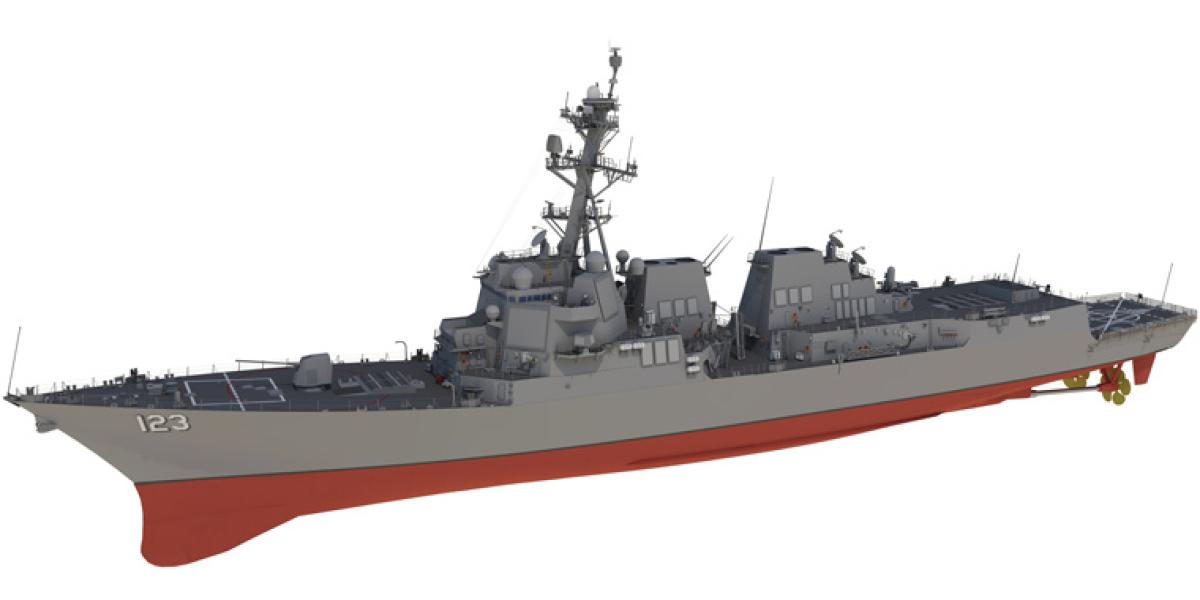The Arleigh Burke–class guided-missile destroyers are the backbone of the Fleet. For the past 20 years, the DDG-51s have evolved to meet the latest threats. Originally designed to combat Soviet aircraft and submarines, the Burkes proved their versatility and flexibility in two Persian Gulf wars and cemented the Navy’s role in ballistic-missile defense (BMD).
With a lot of life remaining in the latest Flight IIA design and the advanced Flight III variant on the drawing board, it is clear the DDG-51s will be the surface warships for the Navy in the 21st century. The Flight IIA can grow to 10,000 tons full-load displacement, an addition of some 700 tons, without compromising stability and seaworthiness. It features the ninth generation of the Aegis weapon system—which has been the heart of the Navy’s surface forces since the cruiser USS Ticonderoga (CG-47) was commissioned in January 1983. New open-architecture combat systems and sensors are bringing increased capabilities and flexibility to in-service and future DDGs.
With the Flight III design studies still under way, it is too soon to guess at size and cost, but affordability is clearly a top-level requirement. Given the looming constrained fiscal environment, a compelling case can be made for the cost-effectiveness of the Flight III. This design will build on existing DDG-51 programs and infrastructure at the lowest risk. It also will offer the greatest potential for keeping pace with anticipated threats and deliver multimission warfighting capabilities that benefit both in-service modernization and new ship construction.
Flight III is the logical next step for the highly successful Burke program. All 62 ships of Flights I, II, and IIA are in the Fleet. The latest Burkes are fitted with Aegis combat system Baseline 7 Phase 1R, which incorporates cooperative-engagement capability, the evolved Sea Sparrow missile, improved SPY-1D(V) radar, and an open-architecture combat system that facilitates affordable upgrades.
The follow-on Baseline 9 Aegis system will expand the warfighting capability for integrated air and missile defense and naval integrated fire-control counter-air tasks. Other advances include the SM-6 missile, close-in weapon-system block 1B, and multimission signal processor. This integrates air- and ballistic-missile defense capabilities, allowing simultaneous engagement of air-breathing cruise missiles and aircraft as well as ballistic missiles and incorporates enhancements to radar performance in the littoral.
It also brings an open-architecture common-source library for Aegis, reusable track-manager/track-server components, common display and processor systems, and the Surface Electronic Warfare Improvement Program, an evolutionary future upgrade to the legacy SLQ-32 electronic warfare system that will generate revolutionary capabilities.
The Flight III variant will take full advantage of these and other developments to advance DDG warfighting capabilities. For example, the air and missile defense radar (AMDR) system will fill integrated air and missile defense capability gaps—a multimission capability to achieve area air dominance of the battlespace and BMD tasks. AMDR is a multifunction, active-phased array, dual-band radar that will search, detect, track, and engage airborne and ballistic-missile targets. Consisting of S-band and X-band radars and an advanced radar-suite controller, the AMDR will provide 40 to 50 times the capability to detect, track, and engage targets simultaneously. And it will do so within the weight and volume “footprint” of today’s most capable Aegis system.
Flexibility is critical, and the AMDR will scale to various ship platforms—the first being the Flight III ships—and will be ideal for backfit into existing and forward-fit into future warships. The radar will feature modular “plug-and-fight” software and hardware suites that can scale up or down to meet the footprint, volume, power, and cooling capabilities of specific ship designs.
The next-generation DDG-51 is not a new idea. First considered in the early 1990s, a Flight III variant was shelved when attention turned to the SC-21 (Surface Combatants of the 21st Century) program that culminated in the Zumwalt-class DDG-1000 program—at 14,000-plus tons, a “destroyer” in name only.
After the Zumwalt program was truncated at three ships, the DDG-51 line restarted in Fiscal Year 2010 to continue production of these highly capable and cost-effective ships. Four Flight IIA “re-start” ships have been funded, additional Flight IIA ships are programmed, and a nine-ship multiyear contract will be awarded in FY13. Six of those will be Flight IIA destroyers, and the other three will be Flight III ships, which the Navy will begin to commission in FY23. As many as 42 Flight III ships might be acquired, which will help to reach and sustain a 300-plus-ship Navy. By mid-century, in-service Aegis DDGs could account for one-third of the Fleet.
The bottom line here: Flight III Arleigh Burke destroyers will be the right surface warships to meet the daunting challenges of the 21st century at prices we can afford.



